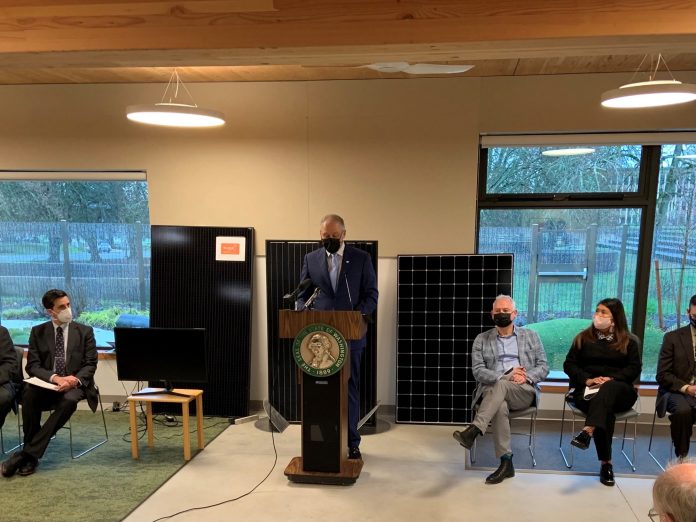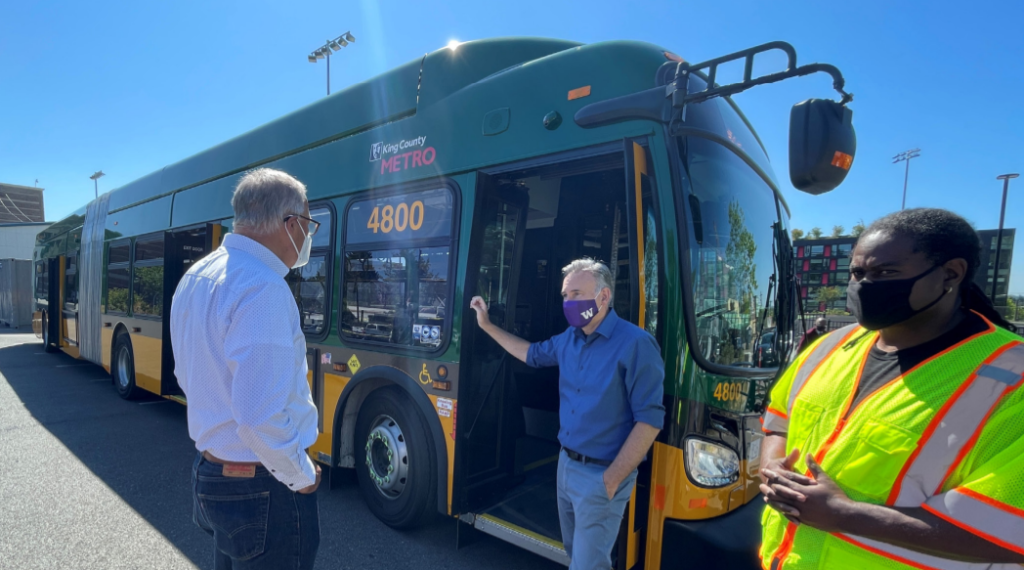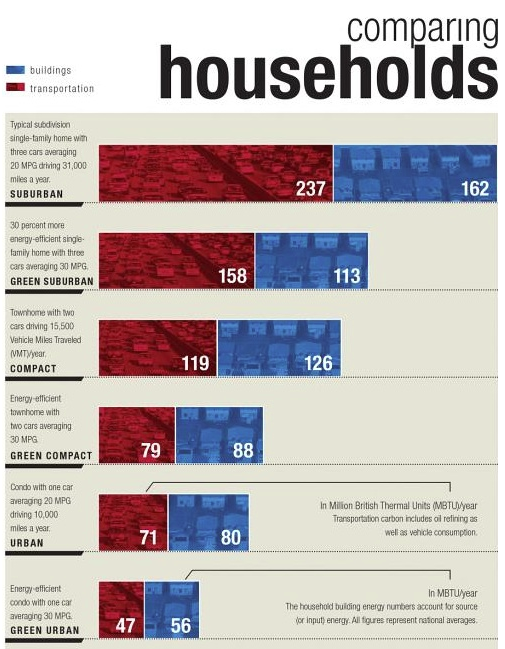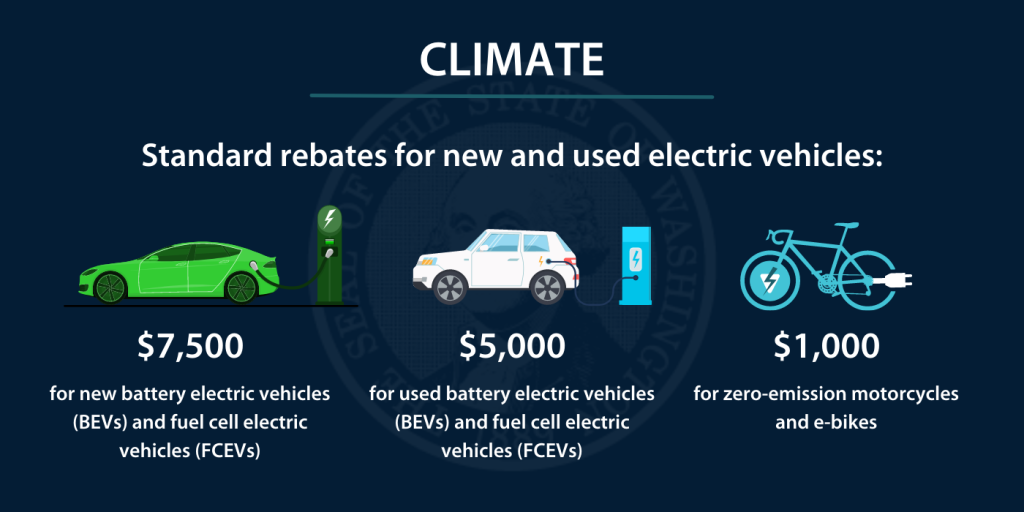
Transit continues to take a back seat, and investments in walking, rolling, and biking are at the symbolic rather than transformative level.
Governor Jay Inslee played the part of electric car salesman as he rolled out a new climate plan seeking to build on progress made last year. With the passage of the Climate Commitment Act in the spring, Inslee finally achieved his long-time goal of setting up a carbon pricing system. However, on Monday, electric cars were the focal point of his remarks, underscored by the row of cars that were backdrop for his announcement.
The Governor’s plan lays out $626 million in climate investments with $100 million per year to provide a generous $7,500 rebate planned for new electric car purchases as the centerpiece program. For low-income individuals, the State of Washington will be picking up an additional $5,000 of the cost of an electric car (new or used) under the proposal. Wisely, the Governor’s plan also includes a $1,000 e-bike rebate, although the fact that conventional bikes, which are even more carbon efficient than e-bikes, were excluded is a significant oversight.
The e-bike rebate could also be made more generous than $1,000. While e-bikes are priced lower than cars, the price differential between a good electric cargo bike and an electric car is significantly less than a factor of 7.5. Wired‘s top-rated electric cargo bike is listed at $6,000, for example. And if climate impact is the focus, an e-cargo bike purchase would take a much bigger bite out of emissions than an electric car purchase. Electric cars come with much more embodied carbon emissions from manufacture and distribution than e-bikes due to much greater vehicle weight. They also require land use policy that provides ample parking and road space to make way for the much larger vehicles.
The logic for the electric car rebate is to try to drive down the cost of electric cars to the level of comparable conventional engine cars. The Governor’s policy brief noted that seven states have adopted point-of-sale rebates and that President Joe Biden has also proposed them.
“To persuade more consumers to purchase electric vehicles (EV) instead of gas-powered vehicles, Inslee proposes $100 million a year (on an ongoing basis) for a customer rebate that would reduce upfront buying costs and make EV prices comparable to those of internal combustion engine vehicles,” the brief states. “Point-of-sale rebates have become the standard for EV sales incentives nationally and have been adopted by Oregon, California, Connecticut, Massachusetts, New York, Pennsylvania and Texas, as well as proposed in the federal Build Back Better Act.”
The state department of commerce would oversee the program, which would be capped at $55,000 for electric car purchases and $80,000 for electric truck, SUV, or van purchases and vary by vehicle type and suggested retail price. “These basic rebates will be available to people who earn under $250,000 per year as a single-tax filer, or under $500,000 per year for joint-filer households,” the brief said.
The policy brief explained that the added rebate of $5,000 for low-income individuals by noting that working class folks typically bear the brunt of road pollution.
“Making zero-emission vehicles accessible for income-qualified Washingtonians would significantly improve air quality in the most polluted areas of our state by taking older, fuel-inefficient cars off the road,” the brief said. “Individuals with an income below $61,000 (60% of state median income) will get an additional $5,000 rebate toward the purchase of a new or used EV. This will reduce the upfront costs for low-income vehicle buyers and avoid simply replacing aging internal combustion engine vehicles with newer, fossil fuel-powered cars.”
The Governor set four overarching goals for his climate strategy: (1) decarbonize the building sector, (2) successfully implement the Climate Commitment Act, (3) invest more in clean transportation, and (4) build the clean energy future in Washington.
“We have made good progress in our state, but it is not enough, and we must do more. Now is the time to act boldly and quickly — to protect the planet and to grow our economy with clean energy jobs,” Inslee added.
Clean transportation investments
Specifically, Governor Inslee has proposed to invest nearly $450 million in cleaner fuel ferries, statewide EV charging infrastructure, clean bus technology, and improvements to transit, bicycle and pedestrian infrastructure. The state ferry system will see the biggest investment by far with “$323.9 million of new funding in the Puget Sound Capital Construction Account, supported by a one-time transfer from the state General Fund for ferry electrification, specifically to: Fully fund the first 144-car hybrid-electric ferry, build a second 144-car hybrid-electric ferry, [and] convert the second Jumbo Mark II vessel to hybrid-electric.”
The remaining millions would be sprinkled out as follows:
- $33 million in additional capital and planning grants to help transit agencies shift to clean alternative fuel buses with at least 50% set aside to support transit alternative fuel grants and planning efforts in overburdened communities. (Carbon Emissions Reduction Account)
- $22.9 million in additional funding to support EV charging infrastructure, education, outreach, and EV adoption. (Federal National Electric Vehicle Program funds, Carbon Emissions Reduction Account, Multimodal Account)
- $45 million in additional funding to support safe routes to school and bicycle and pedestrian safety grants with at least 50% set aside to support projects in overburdened communities. (Carbon Emissions Reduction Account)
- $30 million for special needs transit grants with at least 50% set aside to support grants in overburdened communities. (Carbon Emissions Reduction Account)
- $7.2 million to fund state bikeways and trail networks that complete and connect regional trails. (Federal Carbon Reduction Program)
- $10 million to fund a new transit access grant program. This will support increased levels of service at transit agencies with at least 50% set aside to support transit access in overburdened communities. (Carbon Emissions Reduction Account)
- $4 million in bonds to support the Mount Vernon Library Commons Project, which includes the addition of 75 EV charging stations, doubling the capacity of public EV charging along the I-5 corridor between Seattle and Vancouver, British Columbia.
Some of the funding comes from the federal Bipartisan Infrastructure Law, while some comes via the Climate Commitment Act. The Governor estimates $127.3 million in new funds generated by the Climate Commitment Act will be available to use for clean transportation activities in the last quarter of the current biennium. The state bikeway and regional trail spending in the plan, such that it is, comes from the federal infrastructure bill.

While state ferries would get a $324 million infusion over three years and electric cars get a $100 per million rebate plus $30 million in charging infrastructure, transit gets just $40 million in grants. This underinvestment is part of a long tradition in Washington State — many other states invest much bigger stares of their budgets in transit. Better transit could shift transportation choices away from carbon-intensive private vehicles, which could have a huge impact. Ferries account for just 0.4% of state transportation emissions, according to the state inventory.
Electrifying cars is a necessary and important step, but state climate goals will remain unachievable unless we also reduce vehicle miles travelled. Without big state investments in transit, it’s no surprise there hasn’t been much progress on that front.
Many state transit agencies have plans to electrify their buses, but they struggle to fund them. King County Metro’s bus electrification plan remains largely unfunded as does its Metro Connects plan to expand the RapidRide frequent transit network. Fully funding both will take billions, which makes the $40 million in statewide grants a real pittance of the need. A recent purchase of 40 battery buses cost Metro about $50 million.
Decarbonizing the building sector
Governor Inslee’s plan to decarbonize the building sector is a bit less fleshed out and immediate, but one goal is to phase out natural gas infrastructure in new buildings. To achieve that, the Governor promises to raise standards for energy performance in new multifamily and commercial buildings. It’s not clear how single-family homes (which are the most energy intensive homes per capita) would be decarbonized.

“To tackle emissions from existing buildings, Inslee proposes expanding the state’s existing building energy performance standards to all buildings over 20,000 square feet, including large multifamily buildings,” the Governor’s Office said. “Higher standards in these buildings are needed when it comes to energy usage, and the governor’s proposal includes incentives for owners to reach those standards.”
The plan also raises the idea of a “net-zero ready” requirement on new construction — although that wouldn’t kick in until 2034.
“The greatest source of emissions from the building sector comes from using natural gas for space and water heating,” the Governor’s brief states. “Inslee proposes a ‘net-zero ready’ requirement for all new construction that begins in 2034. This means each project reduces energy use by 80%, uses all-electric equipment and appliances, implements electrical panel capacity and wiring for solar panels, and incorporates electric vehicle charging and battery storage. Electric appliances and equipment are already commercially available and cost-effective. Meeting this net-zero goal would establish a clear deadline to discontinue using fossil fuels in new homes and buildings.”
At 23% of state climate emissions, the building sector is the second largest source after transportation, which accounts for 45% state emissions, according to a 2018 Washington State Department of Ecology inventory.
Looking ahead
New Senate Transportation Committee Chair Marko Liias (D-Edmonds) joined Inslee with a supportive statement in his press release. This could signal a clearer path for Inslee’s climate plan than existed when Senator Steve Hobbs led the committee and sometimes withheld his vote on climate measures, such as the clean fuels standard, and was a frequent obstacle to Inslee’s climate agenda. In November, Inslee appointed Hobbs Secretary of State, filling a vacancy created when Republican Kim Wyman accepted a top post in the Biden administration.
Between this development and a strong 2021 legislative session, Inslee seemed bullish about his climate plan’s prospects — even if the conventional wisdom is that less gets done in a short election-year session when state legislators are hesitant to rock the boat. In his announcement, Governor Inslee pushed back against the notion that the short two-month session scheduled in 2022 should be a reason for complacency or low expectations.
“We are challenging the notion that lawmakers can’t take bold, transformative actions when the calendar calls for a short, supplemental legislative session. Climate change does not take off-years, and we cannot wait around as certain calamity circles us,” Inslee said in a statement. “We can do this, and I thank our legislative partners in this effort.”
Clarification: This article has been updated to note that the threshold for the low income rebate is measured at individual level not households.
Doug Trumm is publisher of The Urbanist. An Urbanist writer since 2015, he dreams of pedestrian streets, bus lanes, and a mass-timber building spree to end our housing crisis. He graduated from the Evans School of Public Policy and Governance at the University of Washington in 2019. He lives in Seattle's Fremont neighborhood and loves to explore the city by foot and by bike.



